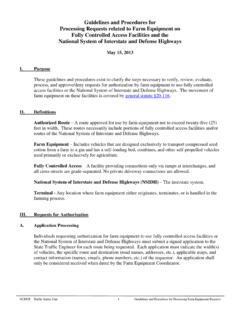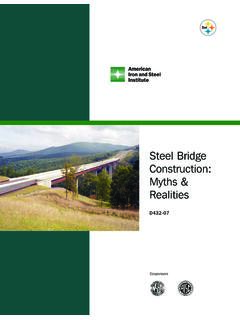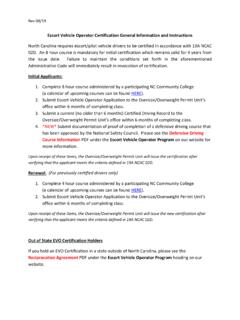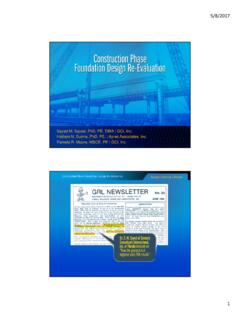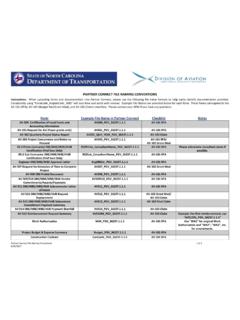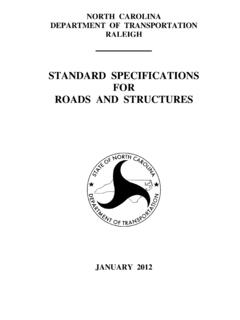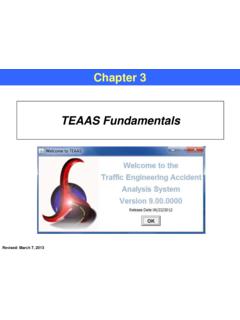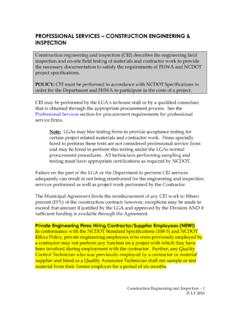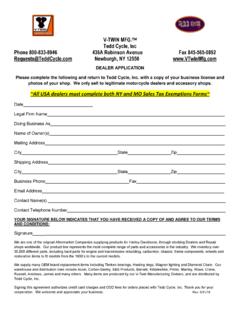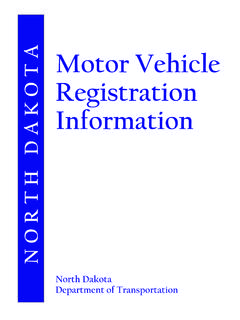Transcription of North Carolina Laws - NCDOT
1 Rev. 3/2/10 1 North Carolina LAWS Publication L-14 Relating to Commercial Vehicles 20-51. Exempt from registration . The following shall be exempt from the requirement of registration and certificate of title: (1) Any such vehicle driven or moved upon a highway in conformance with the provisions of this Article relating to manufacturers, dealers, or nonresidents. (2) Any such vehicle which is driven or moved upon a highway only for the purpose of crossing such highway from one property to another. (3) Any implement of husbandry, farm tractor, road construction or maintenance machinery or other vehicle which is not self-propelled that was designed for use in work off the highway and which is operated on the highway for the purpose of going to and from such nonhighway projects.
2 (4) Any vehicle owned and operated by the government of the United States. (5) farm tractors equipped with rubber tires and trailers or semitrailers when attached thereto and when used by a farmer, his tenant, agent, or employee in transporting his own farm implements, farm supplies, or farm products from place to place on the same farm , from one farm to another, from farm to market, or from market to farm . This exemption shall extend also to any tractor, implement of husbandry, and trailer or semitrailer while on any trip within a radius of 10 miles from the point of loading, provided that the vehicle does not exceed a speed of 35 miles per hour.
3 This section shall not be construed as granting any exemption to farm tractors, implements of husbandry, and trailers or semitrailers which are operated on a for-hire basis, whether money or some other thing of value is paid or given for the use of such tractors, implements of husbandry, and trailers or semitrailers. (6) Any trailer or semitrailer attached to and drawn by a properly licensed motor vehicle when used by a farmer, his tenant, agent, or employee in transporting unginned cotton, peanuts, soybeans, corn, hay, tobacco, silage, cucumbers, potatoes, all vegetables, fruits, greenhouse and nursery plants and flowers, Christmas trees, fertilizers or chemicals purchased or owned by the farmer or tenant for personal use in implementing husbandry, irrigation pipes, loaders, or equipment owned by the farmer or tenant from place to place on the same farm , from one farm to another, from farm to gin, from farm to dryer.
4 Or from farm to market, and when not operated on a for-hire basis. The term "transporting" as used herein shall include the actual hauling of said products and all unloaded travel in connection therewith. (7) Those small farm trailers known generally as tobacco-handling trailers, tobacco trucks or tobacco trailers when used by a farmer, his tenant, agent or employee, when transporting or otherwise handling tobacco in connection with the pulling, tying or curing thereof. (8) Any vehicle which is driven or moved upon a highway only for the purpose of crossing or traveling upon such highway from one side to the other provided the Rev.
5 3/2/10 2owner or lessee of the vehicle owns the fee or a leasehold in all the land along both sides of the highway at the place or crossing. (9) Mopeds as defined in (27)d1. (10) Devices which are designed for towing private passenger motor vehicles or vehicles not exceeding 5,000 pounds gross weight. These devices are known generally as "tow dollies." A tow dolly is a two-wheeled device without motive power designed for towing disabled motor vehicles and is drawn by a motor vehicle in the same manner as a trailer. (11) Devices generally called converter gear or dollies consisting of a tongue attached to either a single or tandem axle upon which is mounted a fifth wheel and which is used to convert a semitrailer to a full trailer for the purpose of being drawn behind a truck tractor and semitrailer.
6 (12) Motorized wheelchairs or similar vehicles not exceeding 1,000 pounds gross weight when used for pedestrian purposes by a handicapped person with a mobility impairment as defined in (13) Any vehicle registered in another state and operated temporarily within this State by a public utility, a governmental or cooperative provider of utility services, or a contractor for one of these entities for the purpose of restoring utility services in an emergency outage. (14) Electric personal assistive mobility devices as defined in (7a). (15) Any vehicle that meets all of the following: a. Is designed for use in work off the highway.
7 B. Is used for agricultural quarantine programs under the supervision of the Department of Agriculture and Consumer Services. c. Is driven or moved on the highway for the purpose of going to and from nonhighway projects. d. Is identified in a manner approved by the Division of Motor Vehicles. e. Is operated by a person who possesses an identification card issued by the Department of Agriculture and Consumer Services. (16) A vehicle that meets all of the following conditions is exempt from the requirement of registration and certificate of title. The provisions of continue to apply to the vehicle and to the person in whose name the vehicle would be registered.
8 A. Is an agricultural spreader vehicle. An "agricultural spreader vehicle" is a vehicle that is designed for off-highway use on a farm to spread fertilizer, seed, lime, or other agricultural products on a field. b. Is driven on the highway only for the purpose of going from the location of its supply source for fertilizer or other products to and from a farm . c. Does not exceed a speed of 35 miles per hour. d. Does not drive outside a radius of 50 miles from the location of its supply source for fertilizer and other products. e. Is driven by a person who has a license appropriate for the class of the vehicle. f. Is insured under a motor vehicle liability policy in the amount required under 20-309.
9 G. Displays a valid federal safety inspection decal if the vehicle has a gross vehicle weight rating of at least 10,001 pounds. (1937, c. 407, s. 16; 1943, Rev. 3/2/10 3c. 500; 1949, c. 429; 1951, c. 705, s. 2; 1953, c. 826, ss. 2, 3; c. 1316, s. 1; 1961, cc. 334, 817; 1963, c. 145; 1965, c. 1146; 1971, c. 107; 1973, cc. 478, 757, 964; 1979, c. 574, s. 6; 1981 (Reg. Sess., 1982), c. 1286; 1983, cc. 288, 732; 1987, c. 608; 1989, c. 157, s. 2; 1991, c. 411, s. 4; 1995, c. 50, s. 4; 1999-281, s. 2; 2002-98, s. 4; 2002-150, s. 1; 2006-135, s. 2; 2007-194, s. 1; 2007-527, s. 41.) 20-88. Property-hauling vehicles. (a) Determination of Weight.
10 For the purpose of licensing, the weight of self-propelled property-carrying vehicles shall be the empty weight and heaviest load to be transported, as declared by the owner or operator; provided, that any determination of weight shall be made only in units of 1,000 pounds or major fraction thereof, weights of over 500 pounds counted as 1,000 and weights of 500 pounds or less disregarded. The declared gross weight of self-propelled property-carrying vehicles operated in conjunction with trailers or semitrailers shall include the empty weight of the vehicles to be operated in the combination and the heaviest load to be transported by such combination at any time during the registration period, except that the gross weight of a trailer or semitrailer is not required to be included when the operation is to be in conjunction with a self-propelled property-carrying vehicle which is licensed for 6,000 pounds or less gross weight and the gross weight of such combination does not exceed 9,000 pounds.
